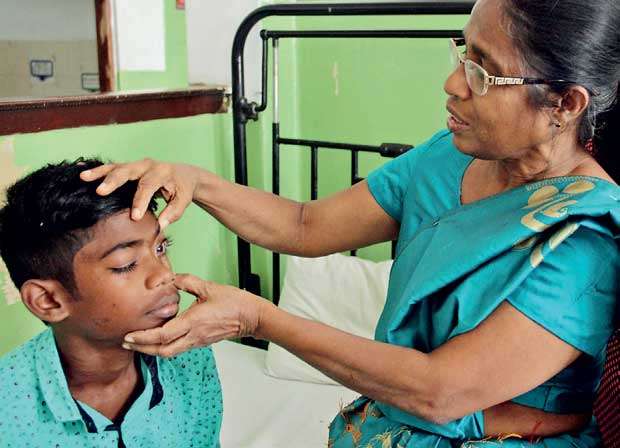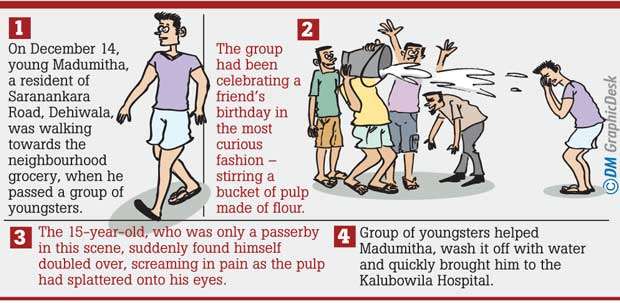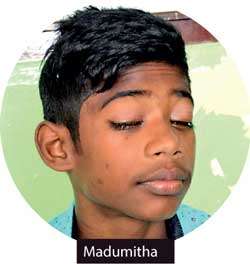29 Jan 2019 - {{hitsCtrl.values.hits}}
Pranks involving flour or pulp attacks are catching on among the local youth as a result of social media trends

Pix by Pradeep Dilrukshana

 A humble boy of fifteen, sits with his eyes firmly shut, hunched on a bed at a crowded ward of the National Eye Hospital in Colombo. Life has dealt a hard blow on Madumitha, who is just months away from sitting for the decisive GCE Ordinary Level Examination. The child is now forced to attend clinic sessions at the National Eye Hospital and receive treatment; a process which will continue for several months.
A humble boy of fifteen, sits with his eyes firmly shut, hunched on a bed at a crowded ward of the National Eye Hospital in Colombo. Life has dealt a hard blow on Madumitha, who is just months away from sitting for the decisive GCE Ordinary Level Examination. The child is now forced to attend clinic sessions at the National Eye Hospital and receive treatment; a process which will continue for several months.
 He has been a victim of the most unusual accident. On December 14, young Madumitha, a resident of Saranankara Road, Dehiwala, was walking towards the neighbourhood grocery, when he passed a group of youngsters. According to Madumitha the group had been celebrating a friend’s birthday in the most curious fashion – stirring a bucket of pulp made of flour. The 15-year-old, who was only a passerby in this scene, suddenly found himself doubled over, screaming in pain as the pulp had splattered onto his eyes.
He has been a victim of the most unusual accident. On December 14, young Madumitha, a resident of Saranankara Road, Dehiwala, was walking towards the neighbourhood grocery, when he passed a group of youngsters. According to Madumitha the group had been celebrating a friend’s birthday in the most curious fashion – stirring a bucket of pulp made of flour. The 15-year-old, who was only a passerby in this scene, suddenly found himself doubled over, screaming in pain as the pulp had splattered onto his eyes.
“It started to burn,” Madumitha recalls. “They didn’t expect this to happen,” he says referring to the pulp-stirring group of youngsters. “They helped me wash it off with water and quickly brought me to the Kalubowila Hospital. The doctor, who examined me, instructed me to wash my eyes for about half an hour. So we found a faucet and started washing my eyes. But a man at the hospital said there were a lot of patients awaiting their turn and urged us to stop washing,” the child recollects. Madumitha, who was then referred to another doctor at the hospital, was prescribed treatment, which included eye drops to be administered every two hours. “I was asked to attend the clinic and was given the choice of either continuing with treatment at the Kalubowila Hospital (Colombo South Teaching Hospital) or the National Hospital. They suggested that it would be better for me to receive treatment at the National Hospital, so we came here,” Madumitha says.
not familiar with first-aid
In the event of any chemical contact with the eye, doctors advise completely flushing the substance out. “Rather than rushing the patient to the hospital, it is important to flush out the substance with water, until there is no foreign substance in the eye. Sadly Sri Lankans are not familiar with first-aid and rush patients to the hospital, where the foreign substance such as lime, causes more damage to the eye,” Consultant Eye Surgeon Dr. Manel Pasqual observes.
Last week, we had another child who had suffered from edible lime paste squirted into the eye. Edible lime consumed with betel leaf, is yet another deadly substance which can cause severe pain
“This was not a deliberate attack,” stresses H.P. Sandamali, the young boy’s mother. Asked as to how she was informed about the accident, Sandamali says she received the news through friends of Madumitha. “The kids on the road had made the pulp out of rice flour in an old bucket which had been used to mix lime plaster. They had started to toss pulp at each other and Madumitha had been passing by,” Sandamali says with a lax tone, seemingly unaware of the gravity of the mishap.
Medically described as a chemical burn, this type of injury can result in a number of outcomes ranging from discomfort to permanent damage and can possibly be blinding and life-altering for a victim. Madumitha is a fortunate patient, according to Dr. Pasqual. This is because has not suffered grave damage to his eyes. “A number of patients we treat here come with severe damage. Despite only a slight burn, this patient finds it hard to open his eyes or face sunlight,” Dr. Pasqual says while examining Madumitha’s reddened and teary eyes. “He must attend clinical sessions continuously and we have to observe his progress. His vision has to be tested and treated regularly,” adds the doctor.
Chemical injuries of this kind are common and all too frequent according to Dr. Pasqual. “Last year, during the sports meet season, we had a number of children admitted here with severe chemical burns in the eye. A student was admitted with chemical burns after a group of kids had attacked each other with quicklime that had been used to mark tracks on the field, during the sports meet. The child couldn’t open his eyes. Burns caused by lime result in excruciating pain and therefore we had to treat the child for days on end,” she says.
Asked of how long treatment could take, Dr. Pasqual says depending on the severity of the injury, treatment can take from months to even years and may even last a lifetime. “In this case, Madumitha must attend sessions at the clinic for at least three months, even though the burns have been relatively mild. I presume that his vision will not deteriorate significantly, but the burning sensation, redness and an inability to go out in the sunlight will persist for the next three to four months at least. Even so, as he is a child about to sit for his O/L Examinations, recovery will be quite a challenge for him,” she notes.

The kids on the road had made the pulp out of rice flour in an old bucket. They had started to toss pulp at each other and Madumitha had been passing by
- Sandamali
Unfortunately, injuries related to commonplace chemicals, especially in the household environment, are a regular sight at the National Eye Hospital, despite awareness efforts by medical professionals. “Last week, we had another child who had suffered from edible lime paste squirted into the eye. Edible lime consumed with betel leaf, is yet another deadly substance which can cause severe pain. Due to the thickness of this substance, it tends to stick to the eye and makes removal and flushing it out with water, even more difficult. Because the burn caused by lime is so severe, injuries in children are often complicated to treat. Children close their eyes in order to relieve the burn and we often sedate or administer a tranquilizer to flush out the substance from the eyes. The child we treated here was eight years old and we had to follow with three or four surgeries to restore the child’s vision as much as we could. Still such a victim’s vision would be poor,” Dr. Pasqual explains.
Acids and substances such as lime should never be kept within the reach of children, Dr. Pasqual warns. “Medical professionals have constantly warned the public, especially parents, to keep sharp objects such as scissors and knives away from children, but they pay no attention to these warnings. The majority of these accidents we witness at the hospital are preventable,” she adds.

A number of patients we treat here come with severe damage. Despite only a slight burn, this patient finds it hard to open his eyes or face sunlight
- Dr.Manel Pasqual
awareness campaigns
The specialist also warns that accidents related to edible lime are on the rise. “Several years ago, Senior Ophthalmologist Dr. Reggie Seimen, through his awareness campaigns, managed to prohibit the sale of polythene wrapped lime paste. It’s in fact illegal now and we are advised to report such cases to the Ministry of Health. But we have observed a rise in lime paste related accidents which is a cause for concern,” she cautions.
Perhaps it is pertinent to examine how an innocent prank turned into a life threatening mishap. Hospital sources said that pranks involving flour or pulp attacks are catching on among the local youth, as a result of social media trends. Although there have been less reports of fatal injuries or trauma, professionals such as Dr. Pasqual are wary of these emerging trends. Meanwhile the social media platform YouTube, taking similar developments into consideration, has placed a ban on video clips which depict dangerous or emotionally distressing ‘pranks’. The move comes in response to so-called “challenges” that have sometimes resulted in death or injury.
30 Nov 2024 27 minute ago
30 Nov 2024 3 hours ago
30 Nov 2024 5 hours ago
30 Nov 2024 6 hours ago
29 Nov 2024 29 Nov 2024